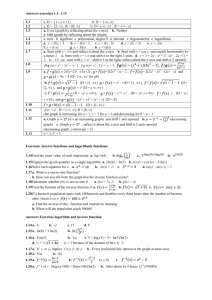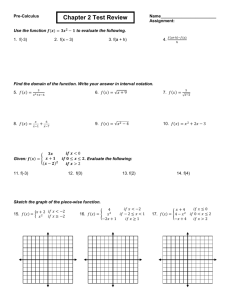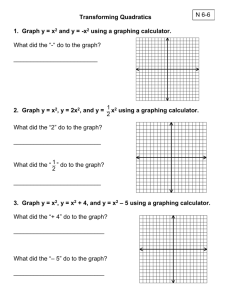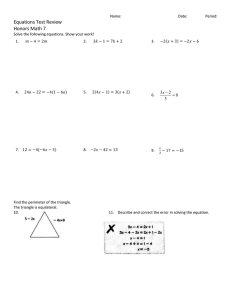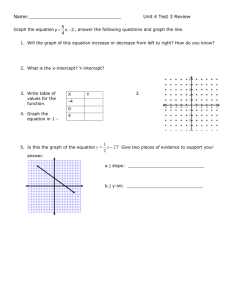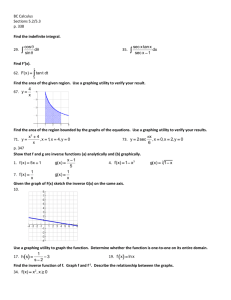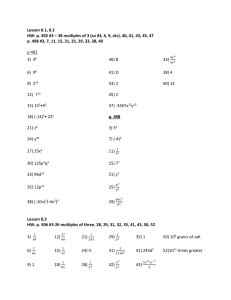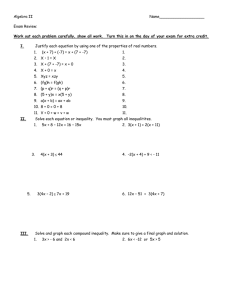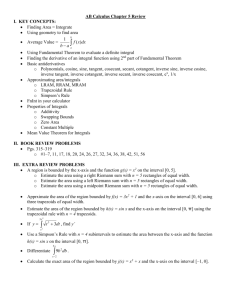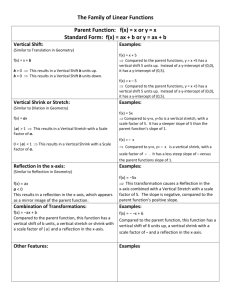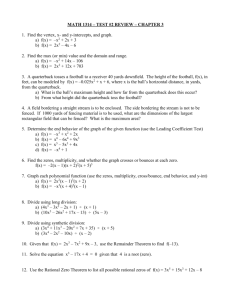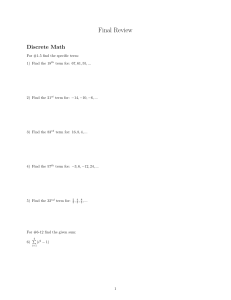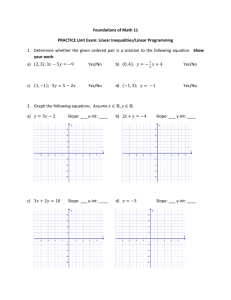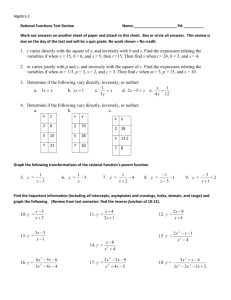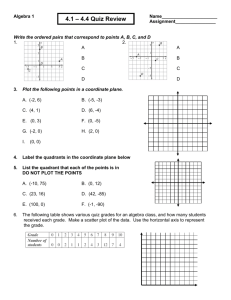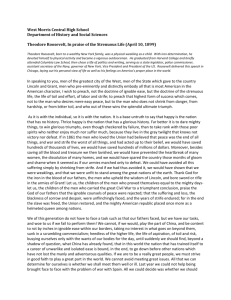Test #1 Review
advertisement
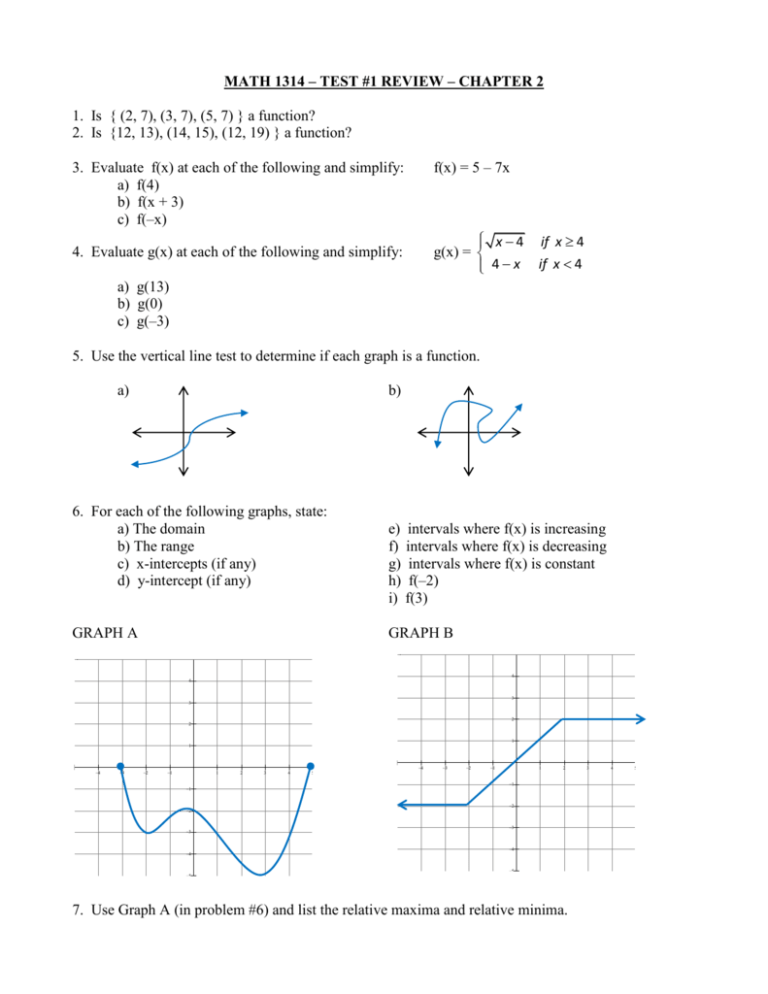
MATH 1314 – TEST #1 REVIEW – CHAPTER 2
1. Is { (2, 7), (3, 7), (5, 7) } a function?
2. Is {12, 13), (14, 15), (12, 19) } a function?
f(x) = 5 – 7x
3. Evaluate f(x) at each of the following and simplify:
a) f(4)
b) f(x + 3)
c) f(–x)
x 4 if x 4
g(x) =
4 x if x 4
4. Evaluate g(x) at each of the following and simplify:
a) g(13)
b) g(0)
c) g(–3)
5. Use the vertical line test to determine if each graph is a function.
a)
b)
6. For each of the following graphs, state:
a) The domain
b) The range
c) x-intercepts (if any)
d) y-intercept (if any)
GRAPH A
e) intervals where f(x) is increasing
f) intervals where f(x) is decreasing
g) intervals where f(x) is constant
h) f(–2)
i) f(3)
GRAPH B
7. Use Graph A (in problem #6) and list the relative maxima and relative minima.
8. Determine if the following functions are even, odd, or neither. Use an algebraic test.
a) f(x) = x3 – 5x
b) f(x) = x4 – 2x2 + 1
9. Graph the following:
2 x if x 0
f ( x)
x if x 0
10. Find the difference quotient for f(x) = 8x – 11
11. Find the difference quotient for f(x) = –2x2 + x + 10
12. Find the slope of the line passing through the points (3, 2) and (5, 1).
13. Write the slope and y-intercept for each of the following lines:
a) y = 2/5 x – 1
b) f(x) = –4x + 5
14. Graph the following using x- and y-intercepts:
2x – 5y = 10
15. Use the graph of f(x) to graph each function g(x).
a)
b)
c)
d)
g(x) = f(x + 2) + 3
g(x) = ½ f(x – 1)
g(x) = –f(2x)
g(x) = –f(–x) – 1
16. Begin by graphing f(x) = x2, then graph each of the following:
a) g(x) = x2 + 2
b) g(x) = –(x + 1)2
17. Begin by graphing f(x) =
x , then graph g(x) =
x 3
18. Begin by graphing f(x) = x , then graph each of the following:
a) g(x) = x 2 3
b) g(x) =
1
2
x2
19. Find the domain of each function. Write your answers in set-builder notation and interval notation.
a) f(x) = x2 + 6x – 3
4
b) g(x) =
x 7
c) h(x) = 8 2x
x
d) j(x) = 2
x 4 x 21
x 2
e) k(x) =
x 5
20. Find (f◦g)(x), (f◦g)(3), and (g◦f)(x):
a) f(x) = x2 + 3, g(x) = 4x – 1
b) f(x) = x , g(x) = x + 1
21. Find an equation for f –1(x) if f(x) = 4x – 3
22. Find an equation for f –1(x) if f(x) = 8x3 + 1
23. Find an equation for f –1(x) if f(x) =
2
x
5
24. Find the inverse function, then list the domain and range for f(x) and f –1(x)
a) f(x) = 1 – x2, x ≥ 0
b) f(x) = x 1
25. Use the horizontal line test to determine if each of the following graphs represent functions that
have inverses.
a)
b)
26. Graph the inverse of f(x) on the grid provided
f(x)
Answers:
1. Yes
2. No
5.
a) –23
b) f(x + 3) = –16 – 7x
c) f(–x) = 5 + 7x
3.
4.
a) 3
b) 4
c) 7
a) Yes
b) No
6.
GRAPH A
a) [–3,5]
b) [–5,0]
c) (–3, 0) & (5, 0)
d) (0, –2)
e) (–2,0) (3,5)
f) (–3,–2) (0,3)
g) none
h) –3
i) –5
7.
GRAPH B
a) [–∞,∞]
b) [–2,2]
c) (0, 0)
d) (0, 0)
e) (–2,2)
f) none
g) (–∞,–2) (2,∞)
h) –2
i) 2
Relative min: (–2, –3) and (3, –5)
Relative max: (0, –2)
8.
a) Odd
b) Even
9.
10. DQ = 8
13.
11. DQ = –4x – 2h + 1
a) m = 2/5, y-int = (0, –1)
b) m = –4, y-int = (0, 5)
14.
12. m = –½
y-int = (0, –2)
x-int = (5, 0)
15. a) left 2, up 3
b) vertical shrink of ½ , right 1
c) horizontal shrink, reflect over x-axis
d) reflect over x-axis, reflect over y-axis, down 1
16. a) up 2
b) reflect over x-axis, left 1
17. left 3
18.
a) left 2, down 3
19.
a)
b)
c)
d)
e)
20.
a)
(f◦g)(x) = 16x2 – 8x + 4
(f◦g)(3) = 124
(g◦f)(x) = 4x2 + 11
x 3
4
22. f –1(x) =
(f◦g)(x) = x 1
(f◦g)(3) = 2
(g◦f)(x) = x 1
b)
3
x 1
8
3
or
x 1
2
Domain of f –1(x): ,1
Range of f –1(x): 0,
b) f –1(x) = (x – 1)2
Domain of f(x):
Domain of f –1(x):
0,
1,
a) Yes it has an inverse
b) No, it does not have an inverse
–1
Range of f (x):
2
x 5
23. f –1(x) =
a) f –1(x) = 1 x
Domain of f(x): 0,
Range of f(x): ,1
Range of f(x):
25.
x |x isareal number ,
x |x 7 ,7 7,
x |x 4 ,4
x |x 7,3 , 7 7,3 3,
x |x 2, but x 5 2,5 5,
21. f –1(x) =
24.
b) vertical shrink of ½, right 2
1,
0,
26.
